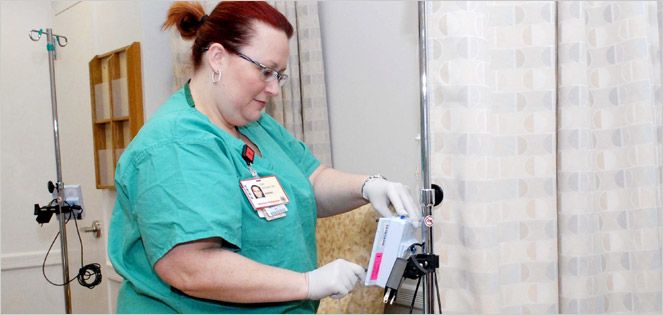
Multiple myeloma is a blood cancer of the plasma cells that develops in the bone marrow. Cancerous plasma cells create an abnormal antibody called a monoclonal protein, or M protein, that builds up and takes over the red cells, white cells, and platelets found in the bone marrow of a healthy individual.
Similar to multiple myeloma, amyloidosis is a disorder of abnormal plasma cells in the bone marrow affecting the protein chains created by the antibodies. The abnormal cells build up in the tissue creating proteins called amyloids, which can affect organs throughout the body.
Additional plasma cell disorders exist that are also characterized by the production of abnormal plasma cells, but don’t meet the requirements for multiple myeloma or amyloidosis.
People with plasma cell disorders may experience a range of symptoms, such as bone pain, anemia, increased infections, kidney problems, and fatigue. Based on the type of symptoms an individual is experiencing and the characteristics of the disease, a number of diverse treatments exist that are currently in use and in development.
Visiting a subspecialty treatment center that is focused solely on the treatment of multiple myeloma and other plasma cell disorders, like the Weill Cornell Medicine Myeloma Center, can provide patients with a complete overview of the available therapy options before starting treatment. Treatments are personalized to the patient via consultation with the oncologist and other members of the multidisciplinary team, including radiation oncologists, stem cell transplant physicians, pharmacists, the research staff, orthopedists, and neurologists.
Not every treatment option is right for every person and discussing the options with a physician who specializes in the treatment of plasma cell disorders is the best way to learn about all the options available to manage symptoms and the disease. The team at the Weill Cornell Medicine Myeloma Center participates in ongoing research initiatives in order to discover new and better treatment options for our multiple myeloma patients.
Learn more about some of the different therapies that may be available.
Drug therapies for multiple myeloma include steroids, immunomodulatory drugs, proteasome inhibitors, histone deacetylase inhibitors, and antibodies, and may be used alone or in combination with each other and chemotherapy regimens. Each therapy works in its own way to destroy the abnormal proteins or myeloma cells present in bone marrow.
Drug therapies for amyloidosis include immunomodulatory drugs, monoclonal antibodies, and proteasome inhibitors, and may be used to target the amyloidosis, as well as treat underlying symptoms caused by the disease.
Chemotherapy is a type of treatment used to destroy cancerous cells in the body. There are several chemotherapy regimens that are used for the treatment of multiple myeloma and each option has a specific goal depending on the type of disease and patient profile. Many chemotherapy regimens are also combined with other therapy options in order to effectively treat the disease.
Stem Cell Transplants are options for some multiple myeloma patients that meet specific criteria, such as adequate organ function, good fitness levels, and the ability to undergo chemotherapy which is sometimes done as part of a pre-transplant regimen. Most stem cell transplants done for the treatment of multiple myeloma are autologous, meaning they use a patient’s own stem cells rather than cells from a donor.
Chimeric antigen receptor (CAR) T-Cell Therapy is a form of immunotherapy that uses a patient’s own immune system to fight multiple myeloma. T-cells are taken from a patient’s blood and modified to produce CAR proteins that help T-cells fight tumor cells.
Radiation therapy uses high energy rays to destroy cancer cells, while keeping normal cells intact. Radiation for multiple myeloma is typically targeted to specific bones that have been identified as weak from the myeloma cells present.
Alternative treatments for multiple myeloma exist that some people turn to in place of traditional therapies. Traditional therapies remain the best option for remission, but some of these therapies may be used in conjunction to manage some side effects. Speaking to a physician about these treatments, and all treatment options, is the best course of action.
Clinical trials may be offered through the Weill Cornell Medicine Myeloma Center. Our team participates in and leads a variety of studies aimed at discovering new drugs or therapies for multiple myeloma that are not yet approved by the FDA. Enrolling in a clinical study may be the best treatment option for patients after an initial myeloma diagnosis or after trying other treatment without favorable response.
Depending on a person’s symptoms or disease stage, some cases require no initial treatment, and a policy of active observation is undertaken. This means that the disease is checked periodically to monitor for stability or growth. Some individuals don’t require treatment for a prolonged period of time (months to years) if the disease is stable.
At the Weill Cornell Medicine Myeloma Center, we tailor treatments specifically to each patient to ensure the best possible option is provided to each person entering our center. Some people find it reassuring to have another medical opinion to help decide about their treatment. The treatment team at the Myeloma Center would be happy to assist in finding another myeloma expert physician to provide a second opinion or to serve in the role of providing a second opinion to you if your treatment is at another facility.

